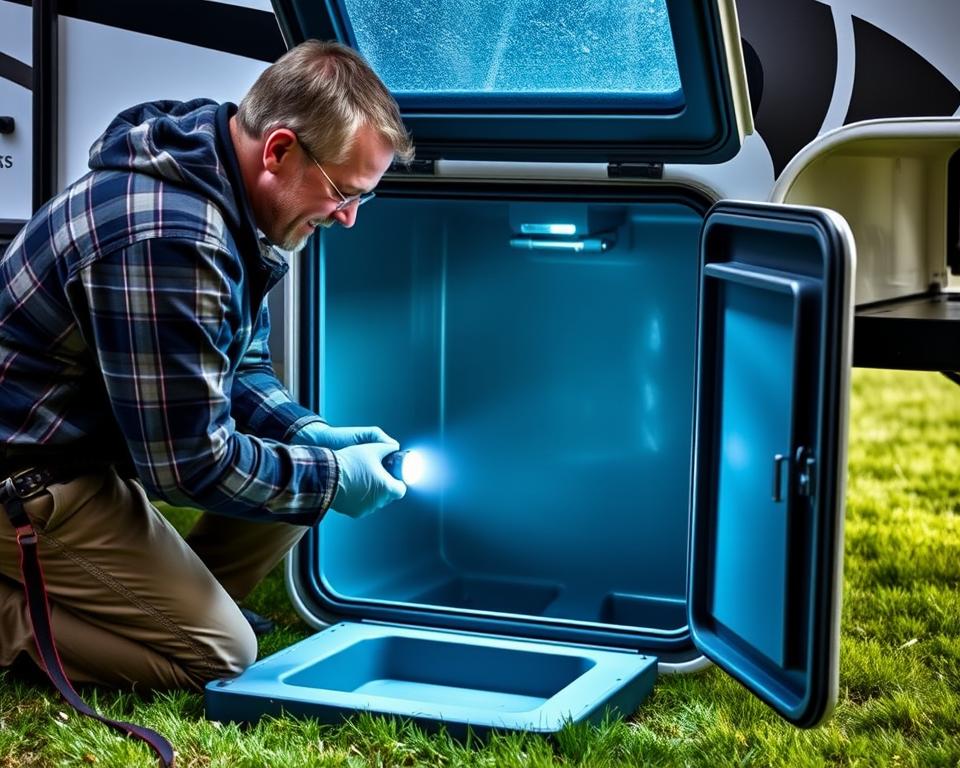Camper Water Tank and Pump: Ultimate Manual
Ever wondered how seasoned RVers maintain perfect water flow while dry-camping? It’s all about your RV water Tank & Pump. Be it heading to national parks or a quick weekend retreat, commanding your RV’s water system is vital. This article we unpack the fundamentals: the parts, upkeep, and best practices for glitch-free travel. Knowing each component, from the pipework to reservoir filling, guarantees water is always on tap during your excursions – RV septic tank pumping cost.
Important Summaries
- Getting familiar with the RV water system elevates your travel adventure.
- The RV fresh-water Tank & Pump are indispensable for a steady water supply.
- Consistent servicing prolongs the lifespan of your RV plumbing.
- Knowing the right way to top up your Tank properly can forestall future issues.
- Diagnosing your water Pump can rescue you from sudden problems.
Demystifying RV Water Systems
RV water systems are split into two main parts: the potable-water setup and the wastewater mechanism. The clean-water circuit boasts several core components like the water Tank, Pump, and faucets, mirroring home plumbing yet tailored for the mobile needs of life on wheels.
Supplying clean water is paramount for the system’s reliability. It safeguards the well-being of all passengers. It’s vital to keep the RV plumbing in prime condition through scheduled maintenance – including proper drainage to prevent leaks and other faults. Proactive inspections let RV enthusiasts dodge water-related headaches during their journeys.

The Role of the RV Fresh-Water Tank
The RV fresh-water reservoir is central for a smooth journey. It houses the clean water required for drinking, cooking, and cleaning. The capacity of this container differs with each RV model, impacting how much water can be stored – and directly dictates how long you can roam before needing a refill.
Keeping the RV storage Tank sanitary is critical. Regular cleaning keeps at bay harmful contaminants, so the water stays safe for use. Skipping maintenance can encourage bacteria or algae growth, making the water hazardous.
Understanding the RV water Tank’s role streamlines water management on the road. Proper upkeep and timely refills provide a care-free experience. It’s key to have ample water for all travel needs, guaranteeing a smooth RV adventure.
Topping Up Your RV Water Tank
Refilling your RV fresh-water reservoir demands meticulous action to confirm it’s done correctly. There are two main methods: gravity-feed filling and pressure filling. Mastering these methods significantly enhances your RV conditions.
Gravity-feed is straightforward. You just need a drink-safe water hose. Attach this hose to a water source, then to the Tank’s opening, and allow gravity take over. Always keep an eye on the water level to avoid spills.
Pressure filling uses a city water connection, offering faster fill times. You should use a pressure regulator to govern water flow. Connect the hose from the municipal source to your RV. This approach delivers speedy and steady supply to your reservoir.
Whichever method you use, adhere to these key safety tips: Consistently monitor the fill when filling to prevent overflow, and use clean water to ward off health issues. Mastering these filling and safety techniques will render your RV trips even more enjoyable.
RV Water Tank and Pump: Key Components Explored
The RV Tank-and-Pump combo are vital to any RV’s plumbing system, delivering a consistent and dependable water supply for all your needs. The RV water Pump’s main job is to push water from the reservoir, ensuring clean water is always on call. That’s vital for cooking, cleaning, and showering.
RV plumbing features different Pump types, each with individual benefits. Diaphragm pumps are favoured for their even water pressure, while centrifugal models are loved for simplicity and efficiency. It’s important to weigh flow rate, noise, and installation ease when picking your Pump.
To wrap up, the RV water Tank and Pump are irreplaceable to your water system’s functioning. A dependable Pump secures strong pressure and smooth flow, improving your overall travel experience.
Choosing the Best-Fit RV Water Pump
Finding the correct RV water Pump is vital for your plumbing’s optimal performance. When evaluating a Pump, factoring in several points is critical for a great camping experience. Ensuring it fits your RV’s water system is key.
Keep these primary aspects in mind:
- Flow Rate: Select a Pump with a flow rate that matches your usage needs. A stronger flow means faster Tank refills.
- Pressure Ratings: Your RV’s various fixtures set the needed pressure levels. Pick a Pump whose specs satisfy those figures for smooth operation.
- Noise Levels: Noise can be an issue with some Pumps. For peace and quiet, compare models for their noise output.
Brands like Shurflo and VEVOR are favourites for many RVers, each offering unique features. A thoughtful assessment of these brands will assist your purchase process.
Understanding these factors is not only important for the right purchase but also arms DIY tinkerers with essential know-how for upkeep and replacements.
Using City Water for Your RV
Hooking your RV to city water provides an effortless supply of fresh water, freeing you from just using your Tank. This delivers a more enjoyable camping experience. Be sure to follow specific steps for a secure hookup.
First, locate the city water connection port on your RV. It’s commonly marked by a bright or black connector, sometimes marked for ease. Grab a potable water hose made for RVs; this grade of hose protects your water safe from contaminants.
It’s essential to install a pressure regulator before making the connection. This gadget safeguards your plumbing by taming the water pressure. With the regulator in place, connect the hose from it to the water source.
Once connected, keep an eye on the water pressure. Aim for a steady, gentle flow to avoid hose damage. Inspect your hoses regularly for any wear or leaks and quickly replace parts as needed.
Adhering to these steps for city hookup boosts your camping convenience and aids in maintaining your RV’s condition.
Maintaining Your RV Fresh-Water Tank
Ensuring your RV’s fresh-water reservoir is well cared for is vital for safe, clean water while on the road. A well-maintained Tank avoids bacterial growth and contamination. For starters, periodically sanitise the Tank: combine water with a bit of bleach for an efficient residue-free clean.
It’s crucial to check leaks and monitor Tank pressure. Regular checks can detect problems early, avoiding expensive fixes. A maintenance routine maintains the water system in excellent health.
To streamline maintenance, create a checklist:
- Check water levels and quality regularly.
- Sanitise the Tank every six months with a bleach solution.
- Inspect for leaks in the reservoir.
- Monitor Tank pressure and Pump function.
- Flush the Tank to eliminate any sediment buildup.
RV Water Pump Troubleshooting
RV water Pump issues can be vexing, upending travel plans unexpectedly. Encountering strange noises, dealing with low pressure, or facing complete Pump failure are typical problems. Knowing how to troubleshoot them can significantly improve your trips.
Hearing odd sounds from your Pump often signals a problem. Start is to check for loose connections and secure them. When you face low water pressure, inspect hoses and fittings for leaks. Because a small leak can greatly affect flow, prompt troubleshooting is critical.
If your Pump fails altogether, test electrical connections. Begin by examining the Pump’s fuse. Should the fuse is fine, look further for wear or damage.
A methodical approach pinpoints and fixes water system issues. Regular maintenance and inspection secure hassle-free journeys.
| Issue | Possible Cause | Suggested Solution |
|---|---|---|
| Strange Noises | Loose connections | Tighten fittings |
| Low Pressure | Leaky hoses/fittings | Find & seal leaks |
| Pump Failure | Electrical fault | Check fuse/wiring |
| No Water Flow | Blocked lines | Flush obstructions |
Hacks for Efficient RV Water Use
Travelling in remote areas typically entails limited water access. Wise use in your RV is crucial. By adopting smart conservation tactics, you not only manage resources well but also heighten camping satisfaction.
For maximum efficiency of water while travelling, consider these tips:
- Take shorter showers – aim for under five minutes.
- Install water-saving fixtures like low-flow showerheads and faucets.
- Reuse grey water: dishwater can flush toilets or water plants.
- Monitor reservoir levels regularly to prevent overflow.
- Plan water stops in advance: know filling stations along your route.
Wrapping Up
Understanding the nuts and bolts of your RV water systems is crucial to a successful travel adventure. The Tank and Pump are at the centre of this, requiring regular upkeep. By servicing these systems, you secure a dependable supply and dodge potential snags.
Consistent troubleshooting and checks limit stress and save time. Being proactive about upkeep is essential, particularly when you’re miles away from help. Proper care enables you to optimise water use, boosting comfort for everyone.
When you head out, keep this guide to tame your RV’s water systems. Making informed choices about plumbing and equipment equip you to embrace the freedom of the road. Wishing you happy and smooth travels ahead!

